Key takeaways:
- Emotional impact in film is created through precise editing choices, sound design, and pacing, forging a deep connection between the audience and characters.
- Editing is crucial for storytelling, shaping how viewers perceive narrative and character development through techniques like shot selection and pacing.
- Music amplifies emotion in film, enhancing scenes and allowing the audience to experience characters’ internal struggles more profoundly.
- Effective editing balances pacing and tension, using timing to evoke feelings of urgency or unease, thereby enriching the viewer’s emotional journey.
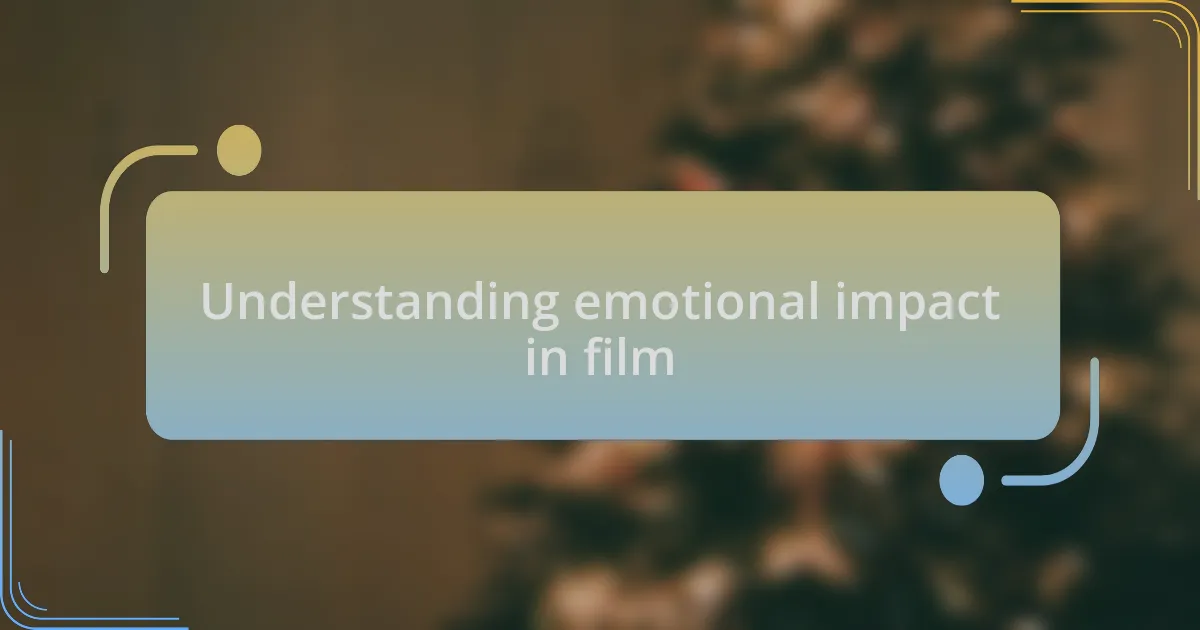
Understanding emotional impact in film
Emotional impact in film is not just about what the story tells, but how it makes us feel. When I watched a particular scene in a movie where the protagonist faced a devastating loss, I felt my heart race and my stomach twist. It was eye-opening to realize that the filmmakers crafted that moment through precise editing choices, music, and pacing, making it profoundly relatable.
Think about your favorite films. What moments made you tear up or feel joy? In my experience, those impactful scenes often rely on the subtle interplay of visual cues and sound design. For instance, the use of close-ups can create a powerful connection with a character’s emotions, inviting the audience into their internal struggle. It’s fascinating how just a couple of seconds can shift from a wide shot of loneliness to a tight frame, revealing raw vulnerability.
I frequently ponder whether filmmakers always understand the emotional weight of their editing choices. Among my various projects, I learned that sometimes, the smallest cut can enhance tension dramatically, leaving the audience breathless. By manipulating timing and rhythm, we can evoke laughter, tears, or even discomfort—showing that emotional impact is truly at the heart of storytelling.

Importance of editing in storytelling
Editing serves as the backbone of storytelling in film. I remember working on a short film where a simple crossfade between two scenes transformed the audience’s understanding of the character’s emotional journey. By carefully selecting how and when to transition from one moment to another, I realized we could guide viewers’ feelings and shape their connection to the narrative.
Consider this: have you ever watched a film where the pacing made you feel breathless or contemplative? In my experience, the rhythm established by editing plays a crucial role in how a story unfolds. Cutting away from a climactic moment just before the big reveal can build intense suspense. It’s a delicate dance between anticipation and satisfaction, and getting it right can turn an ordinary story into something extraordinary.
Moreover, editing has the power to create continuity and coherence in a narrative. I often reflect on a project where, after layered editing, what seemed like disjointed scenes became a cohesive story that resonated with viewers. This transformation underscores that editing is not merely a technical process but an art form that brings emotional depth to storytelling. How would a film feel if its edits stripped away the nuances of emotion? Quite lifeless, I suspect.
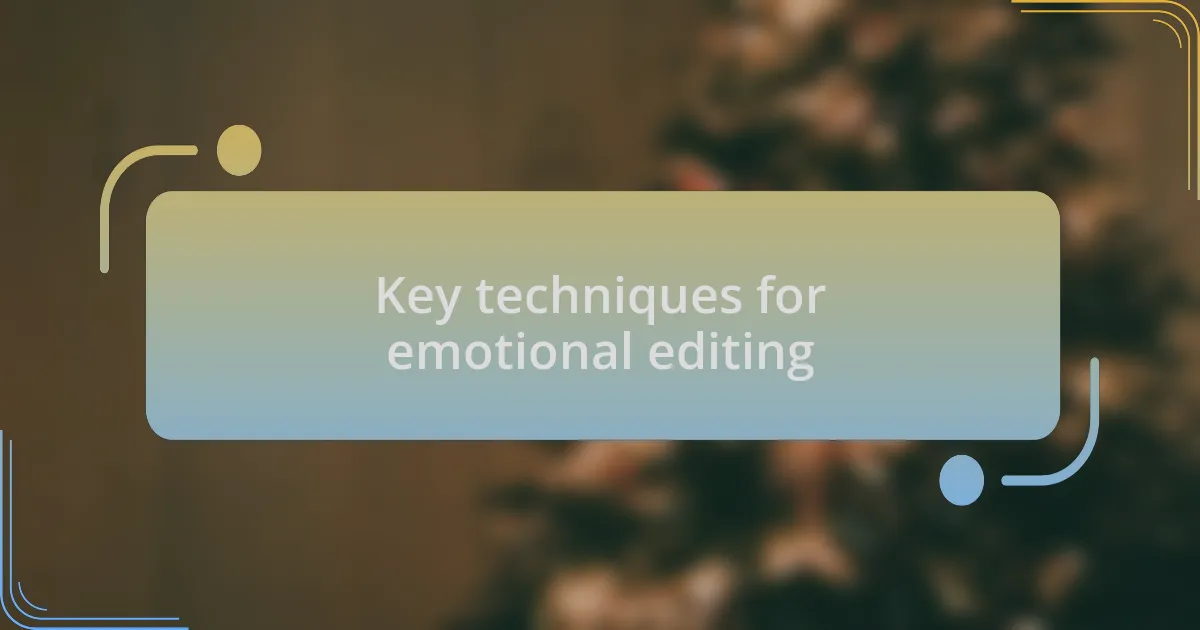
Key techniques for emotional editing
One key technique I’ve found incredibly effective in emotional editing is the use of timing. In one project, I experimented with extending a shot of a character’s expression for just a moment longer than usual. I noticed how that slight adjustment caused the audience to linger on the character’s internal struggle. It’s amazing how sometimes, letting a moment breathe creates a deeper emotional resonance than rapid cuts ever could.
Another powerful approach is the juxtaposition of images. On a recent film, I placed a scene of a joyful memory right next to a heartbreaking moment. The stark contrast triggered a profound emotional response, making the audience grapple with loss in a very personal way. I often wonder how the emotional weight shifts when we put vastly different feelings side by side—have you experienced that in films you’ve seen?
Additionally, sound design can significantly enhance emotional editing. I’ve participated in projects where layering sounds, like a soft heartbeat over an intimate moment, amplified the emotional stakes. It’s fascinating how audio can transform the perception of a visual scene. In my opinion, these auditory elements, when carefully woven into the edit, can evoke feelings that visuals alone might struggle to convey. How do you think you would feel while watching a scene without its accompanying sound?
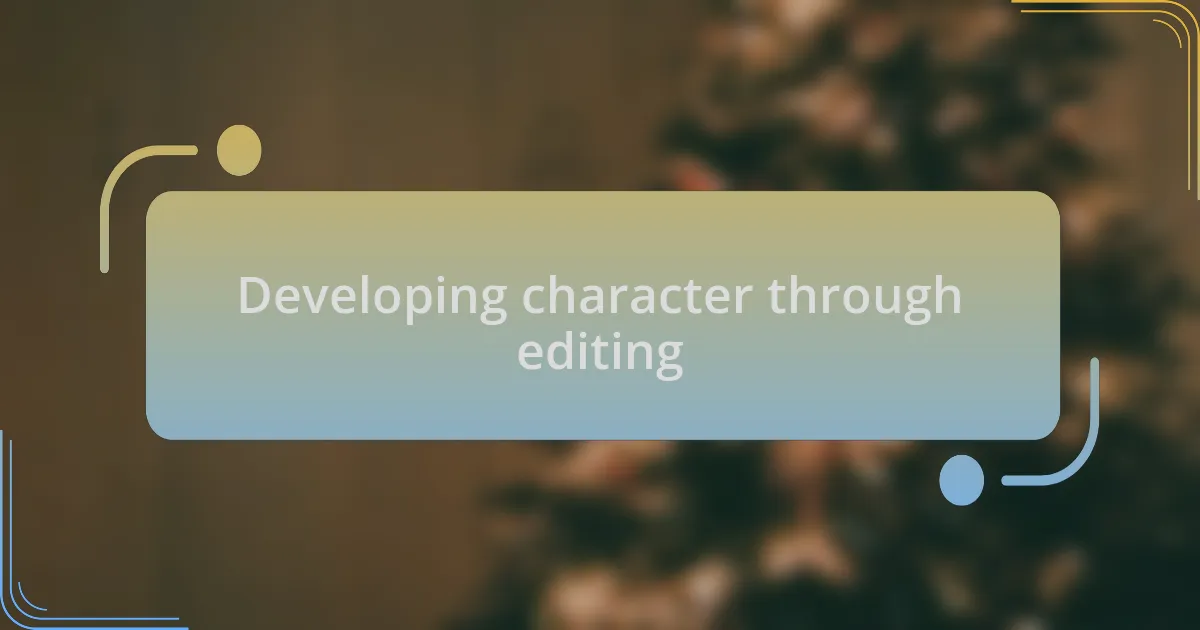
Developing character through editing
One of the most revealing aspects of character development through editing is the sequence of shots that reveal a character’s journey. I recall editing a scene where a character was grappling with their past mistakes. By carefully choosing close-ups to highlight their facial expressions in key moments, I aimed to capture not just their pain but the flickers of hope that emerged. It’s remarkable how a slight change in shot selection can shift the viewer’s perception of who that character really is.
Another technique I’ve found invaluable is the pacing of dialogue versus reaction shots. For instance, while working on a dialogue-heavy scene, I decided to intersperse moments of silence that showcased the other character’s reactions. That pause spoke volumes about their unspoken thoughts and feelings. Have you ever noticed how silence can sometimes say more than words? In my experience, these moments can deepen the audience’s connection to the character, transforming them from mere spectators into emotionally invested participants.
Moreover, utilizing flashbacks or flash-forwards can intricately weave a character’s emotional arc into the narrative. In a project I edited recently, I introduced brief glimpses of a character’s childhood at pivotal moments. These snippets not only provided context but also added layers to their present struggles. When viewers see where a character has come from, it invites them to empathize with their current plight. Reflecting on your own experiences, how do you think knowing more about a character’s past impacts your understanding of their present choices?
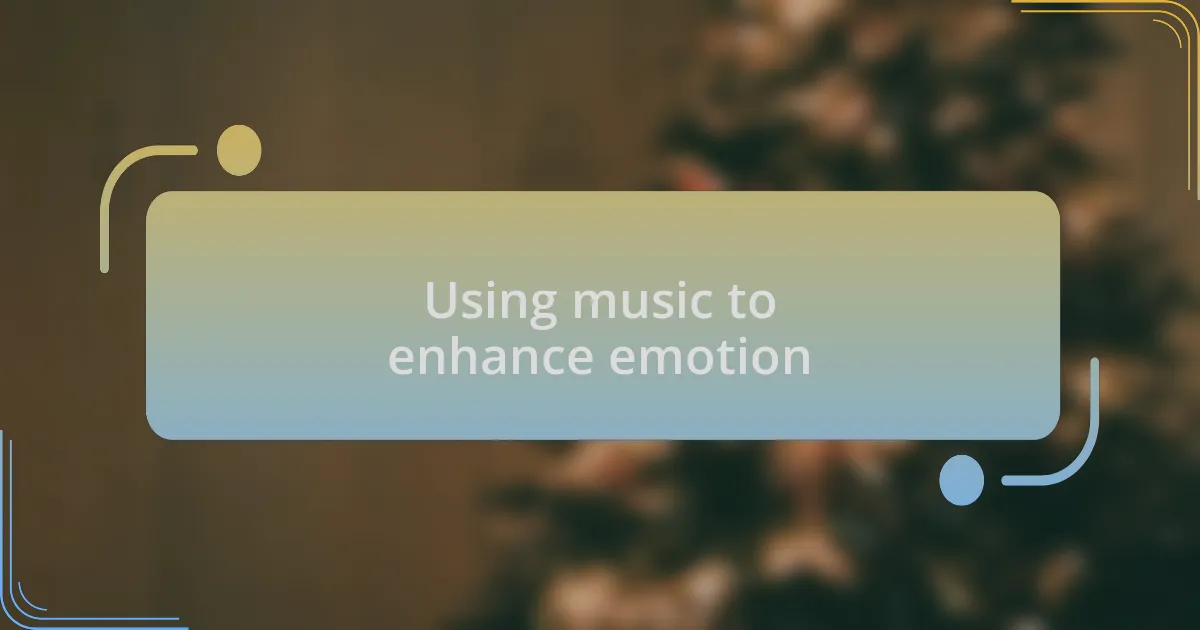
Using music to enhance emotion
When it comes to editing, music serves as a powerful tool to amplify emotional resonance. I’ve often found that the right score can instantly elevate a scene, taking a viewer from merely watching to experiencing. For instance, while editing a dramatic climax, I paired the visuals with a haunting melody that built tension. The emotional weight of that music transformed the entire sequence, allowing viewers to feel the character’s struggle on a deeper level.
In one particular project, I remember working on a romantic scene where the dialogue felt a bit flat. By overlaying a soft, piano-driven soundtrack, the emotional stakes skyrocketed. Suddenly, the subtle glances and hesitant touches became charged with unspoken feelings. Have you ever noticed how certain songs can evoke memories or feelings you thought were long gone? That connection is what I strive to create in my edits – a visceral response that lingers with the audience long after the credits roll.
Moreover, I’ve experimented with contrasting musical themes to portray character development. In one scene, a character evolves from isolation to connection, and the shift in music mirrored that journey. Starting with somber, solitary notes and transitioning to uplifting harmonies allowed the audience to feel the character’s growth. Isn’t it fascinating how a single score can narrate a character’s emotional evolution without a single word spoken? This synergy between music and visuals is something I actively explore in my editing, creating a richer narrative experience.
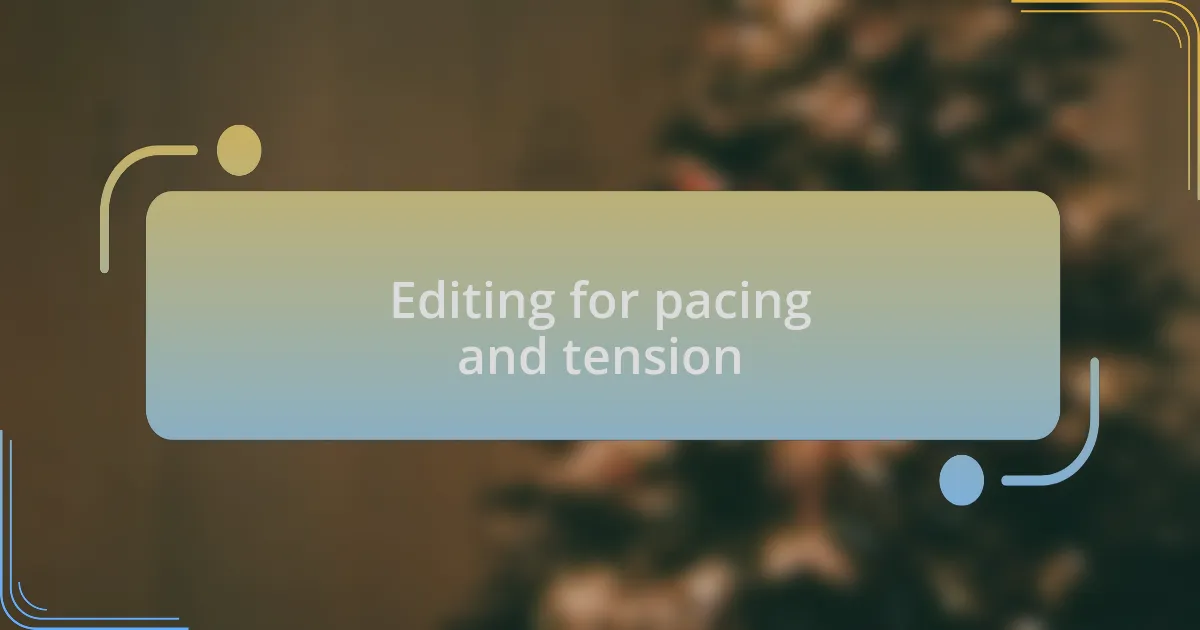
Editing for pacing and tension
Editing for pacing and tension involves a delicate balance of rhythm and timing that can make or break a scene. In my experience, tightening or loosening cuts can significantly affect how a viewer perceives urgency. I recall a suspense sequence where I shifted the cut from a longer shot to quick, abrupt edits. This sudden change elevated the tension, pulling the audience deeper into the moment. Have you ever felt your heart race during a scene that seemed to fly by? That’s the kind of reaction I aim for with pacing.
I also find that varying the length of shots can create a more palpable sense of unease. For example, in one horror project, I deliberately held a single shot for what felt like an eternity, allowing dread to build. The quiet moments between actions can often amplify the fear. Isn’t it intriguing how a single prolonged silence can leave viewers on the edge of their seats, anticipating what’s next?
Additionally, the interplay of fast and slow edits can reveal deeper emotional currents. A rapid sequence might showcase a character’s frantic state of mind, while a slower series of cuts can reflect their introspection. In one film, I juxtaposed frantic traffic scenes with slow-motion glimpses of a character in contemplating failure. This contrast not only heightened the tension but also provided a window into their internal conflict. It’s all about crafting the emotional journey—how do the viewers feel as they ride that wave of pacing alongside the characters? That’s the true art of editing for tension.